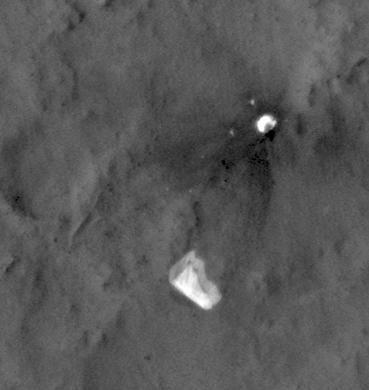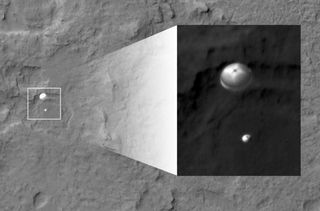NASA Sees Curiosity Rover's Parachute Flapping in Martian Wind (Video)

NASA's most powerful spacecraft orbiting Mars has captured amazing new images of the huge parachute used by the agency's Curiosity rover when it safely landed on the Red Planet last August.
A video of the NASA images of Curiosity's parachute shows it billowing in the Martian wind. The views were recorded by NASA's Mars Reconnaissance Orbiter currently circling the planet.
In all, the MRO spacecraft captured seven photos of Curiosity's huge parachute flapping on the surface of Mars. The images were taken between last Aug. 12 and Jan. 13 using the orbiter's powerful High Resolution Imaging Science Experiment camera, known as HiRISE.
"This sequence shows distinct changes in the parachute," NASA officials explained in an image description. "In the first four images, there are only subtle changes, perhaps explained by differences in viewing and illumination geometry." [See amazing Mars photos by Curiosity]
At some point between Sept. 8 and Nov. 5 (featured in MRO's fourth and fifth photos in the parachute sequence), the parachute underwent a major change in position, in which part of the parachute shifted inward. The move was accompanied by a change in the terrain around the parachute, possibly from dust being kicked up as the parachute moved.
Another movement occurred between Dec. 16 and Jan. 13, when the parachute shifted toward the southeast.
"This type of motion may kick off dust and keep parachutes on the surface bright, to help explain why the parachute from Viking 1 (landed in 1976) remains detectable," wrote planetary scientist Alfred McEwen, the principal investigator for MRO's HiRISE camera at the University of Arizona, in a statement.
Sign up for the Live Science daily newsletter now
Get the world’s most fascinating discoveries delivered straight to your inbox.
NASA's Mars rover Curiosity landed on the Red Planet on Aug. 5. During its descent, the MRO spacecraft used its HiRISE camera to spot the rover descending under its parachute, just before dropping free to begin the risky "sky crane maneuver" that ultimately lowered it down to its Gale Crater landing site.
"Researchers have used HiRISE to study many types of changes on Mars," NASA officials said in a statement. "Its first image of Curiosity's parachute, not included in this series, caught the spacecraft suspended from the chute during descent through the Martian atmosphere."

Curiosity's main parachute was the largest parachute ever used for a Mars landing. When it was fully deployed, the parachute measured 51 feet (15.5 meters) across.
NASA's Curiosity rover is nearly eight months into a planned two-year primary mission to determine if Mars could have ever been habitable for microbial life Last month, NASA announced that Curiosity had succeeded in that objective after the rover analyzed a sample drilled out of a Martian rock.
The powerful Mars Reconnaissance Orbiter launched toward the Red Planet in 2005 and arrived in orbit around the planet in 2006.
This story was provided by SPACE.com, sister site to Live Science. Email Tariq Malik at tmalik@space.com or follow him @tariqjmalik and Google+. Follow us @Spacedotcom, Facebookand Google+. Original article on SPACE.com.

Tariq is the editor-in-chief of Live Science's sister site Space.com. He joined the team in 2001 as a staff writer, and later editor, focusing on human spaceflight, exploration and space science. Before joining Space.com, Tariq was a staff reporter for The Los Angeles Times, covering education and city beats in La Habra, Fullerton and Huntington Beach. He is also an Eagle Scout (yes, he has the Space Exploration merit badge) and went to Space Camp four times. He has journalism degrees from the University of Southern California and New York University.













